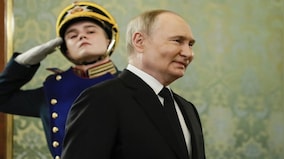The push for the “European sky shield” has recently gained momentum with significant support from Poland and Greece. On Thursday, the Prime Minister of Poland Donald Tusk, and the Greek PM Kyriakos Mitsotakis submitted a letter to the European Commission urging the creation of this unified European air and missile defence system.
What is the proposed sky shield that several European nations have been trying to build since 2022? Why is the need for this system felt?
We explain.
What is the European sky shield initiative?
The European sky shield initiative, formally launched by Germany in October 2022, was spurred on by the Russian invasion of Ukraine. The initiative seeks to enable European countries to jointly procure and train with advanced air defence systems, thus creating a robust, unified defence mechanism across the continent.
Historically, these countries have had a fragmented approach to air defence, with varying levels of capability and readiness. The sky shield initiative aims to address these disparities via a more cohesive and comprehensive defense strategy.
What’s the need for a sky shield in Europe?
The need for such a system has been starkly highlighted by recent events. Russia’s aggression towards Ukraine has raised serious concerns about the adequacy of the existing missile defence capabilities of several European nations.
German Chancellor Olaf Scholz has been a vocal proponent of this initiative, arguing that a combined air defence system is more cost-effective and strategically sound than individual countries attempting to develop their own independent systems. Scholz stressed that significant investments in air defence are inevitable for Europe, and a collaborative approach would provide a stronger and more resilient defence network.
The current state of missile defence in Europe is marked by a mix of outdated and modern systems, with many countries relying on Soviet-era technology. The sky shield initiative aims to modernise and integrate these systems, leveraging advanced technologies like the Arrow 3 and Patriot systems to create a multi-layered defence network capable of addressing a wide range of threats.
The potential benefits of a European sky shield
The European sky shield offers numerous strategic and operational benefits that could significantly enhance the continent’s defence capabilities. Here are some key advantages:
Strengthening deterrence: By establishing a unified and advanced missile defence system, the sky shield increases the uncertainty and risks for potential aggressors. This enhanced deterrence factor is crucial in dissuading adversaries from considering attacks, as the consequences become more unpredictable and severe, according to a commentary by Stiftung Wissenschaft und Politik (SWP).
Cost-effectiveness: Pooling resources and jointly acquiring advanced defence systems allows participating nations to achieve significant cost savings. Instead of each country investing independently in expensive technology, the collaborative approach enables economies of scale and more efficient use of financial resources.
Interoperability and integration: The sky shield promotes interoperability among European nations’ defence systems. By integrating various sensors, command and control assets, and weapon systems into a cohesive network, Europe can achieve a more effective and responsive defence posture. This integrated approach ensures that different systems can work seamlessly together, providing comprehensive coverage and protection.
Rapid deployment and response: With a unified defence system, European nations can respond more swiftly and effectively to emerging threats. The shared resources and coordinated training efforts facilitate quicker mobilisation and deployment of defence assets, enhancing overall readiness and response times.
Enhancing NATO’s capabilities: The sky shield initiative aligns with and strengthens NATO’s Integrated Air and Missile Defence (IAMD) framework. By incorporating the advanced systems into NATO’s existing structure, Europe can bolster its collective defence capabilities and reinforce its commitment to the alliance.
Challenges and the road ahead
Despite the clear benefits, the European sky shield initiative faces several significant challenges that need to be addressed to ensure its successful implementation.
Strategic cacophony: One of the primary challenges is the “strategic cacophony” problem, where domestic imperatives to develop national defense forces and industries can hinder cooperation. For instance, Poland’s initial absence from the sky shield due to tensions with Germany over the deployment of German Patriot systems to Poland highlights the difficulties in aligning national priorities with collective goals, according to a report by the Center for Strategic and International Studies (CSIS). Navigating these domestic and strategic differences requires strong leadership and creative solutions.
Strategic fit: The “strategic fit” problem involves overcoming deep national differences in strategic culture, priorities, and threat perceptions. For the sky shield to be effective, member states must reconcile their varying defence doctrines and operational approaches. This challenge is exemplified by the potential for competing initiatives, such as the French-led air defence proposal announced by President Macron. Ensuring that all participating nations feel their security interests are adequately represented is crucial for the initiative’s success.
Specialisation dilemma: The “specialisation dilemma” refers to the reliance on others to deliver shared capabilities. Not every European nation can afford to develop and field independent air defense systems, necessitating reliance on more capable allies. Smaller nations, in particular, must depend on the broader network for protection against long-range missile threats. While NATO’s existing Air Policing and Air Shielding missions provide some degree of specialisation, further coordination and mutual reliance are necessary to address this challenge effectively.
Technological and logistical hurdles: Implementing the sky shield requires addressing various technological and logistical challenges. Integrating different defence systems from multiple countries into a single, cohesive network is a complex task that demands significant technical expertise and coordination. Ensuring seamless communication and interoperability among diverse systems is essential for the initiative’s success.
Political unity and commitment: Achieving political unity and sustained commitment among participating nations is another critical challenge. The initiative requires continuous political will and financial investment from all member states. Any wavering in commitment or shifts in political priorities could undermine the project’s progress and effectiveness.
Industrial and economic considerations: The sky shield initiative also needs to address industrial and economic considerations. Ensuring that the procurement process is fair and transparent, and that it supports the European defence industry’s growth, is essential. Balancing these economic interests with strategic objectives requires careful planning and negotiation.
The European sky shield represents a significant step towards a more integrated and robust air and missile defense system for Europe. With support from nations like Poland and Greece, the initiative has gained new momentum. However, realising its full potential requires addressing numerous strategic, political, and logistical challenges. The road ahead is complex, but with concerted efforts and sustained commitment, the European sky shield can become a cornerstone of Europe’s defense architecture, ensuring greater security and stability for the continent.
With inputs from agencies







)
)
)
)